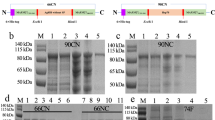Abstract
In this study we investigated the relation between enhanced resistance and delayed hypersensitivity (DH) induced with subcellular preparations from Listeria monocytogenes and the adjuvant dimethyldioctadecylammonium bromide (DDA). Ribosomal RNA as well as cell envelope fragments (fraction I) protected mice against lethal Listeria infection. However, only fraction I induced DH against killed Listeria. For the induction of protection with fraction I or RNA as well as for the induction of DH with fraction I, preparations had to be administered in combination with DDA. Fraction I elicited a DH response in mice immunized with viable Listeria, but RNA did not. These observations pointed to a dissociation between DH and enhanced resistance induced with RNA, and to a dissociation between fraction I and RNA with respect to their ability to induce or elicit DH. Also DH and enhanced resistance induced with fraction I could be dissociated. Intracutaneous administration of fraction I induced high levels of DH without concomitant induction of protection against lethal challenge with Listeria. On the other hand, intraperitoneal administration of fraction I fully protected mice against lethal infection, but only induced a moderate DH response. DH induced with fraction I was largely specific, whereas enhance resistance induced with this preparation was nonspecific. Finally, proteinase K-sensitive proteins were found to be essential for the induction of DH but not for the induction of protection with fraction I.
Similar content being viewed by others
References
Antonissen, A. C. J. M., Lemmens, P. J. M. R., Gonggrijp, R. van den Bosch, J. F. & van Boven, C. P. A. (1985) RNase-sensitive and RNase-insensitive protective components isolated from Listeria monocytogenes. Antonie van Leeuwenhoek 51: 227–240
Antonissen, A. C. J. M., van Kessel, K. P. M., van Dijk, H. & Willers, J. M. N. (1981) Development of a simple passive haemagglutination-inhibition assay for Listeria monocytogenes lipoteichoic acid. J. Immunol. Meth. 44: 351–357
Barry, R. A. & Hinrichs, D. J. (1983) Lack of correlative enhancement of passive transfer of delayed-hypersensitivity and antilisterial resistance when using concanavalin A stimulated primed spleen cells. Infect. Immun. 39: 1208–1213
Bradley, J. V. (1968) Distribution free statistical tests, pp. 195–203. Prentice-Hall, Englewood Cliffs, New Jersey
Chen-Woan, M., Sajewski, D. H. & McGregor, D. D. (1985) T-cell co-operation in the mediation of acquired resistance to Listeria monocytogenes. Immunology 56: 33–42
Gonggrijp, R., Mullers, W. J. H. A., Lemmens, P. J. M. R. & van Boven, C. P. A. (1980) Ribonuclease-sensitive ribosomal vaccine of Pseudomonas aeruginosa. Infect. Immun. 27: 204–210
Gordon, W. C., Prager, N. D. & Carroll, M. C. (1980) The enhancement of humoral and cellular immune responses by dimethyldioctadecylammonium bromide. Cell. Immunol. 49: 329–340
Kaufmann, S. H. E. & Hahn, H. (1982) Biological functions of T cell lines with specificity for the intracellular bacterium Listeria monocytogenes in vitro and in vivo. J. Exp. Med. 155: 1754–1764
Kaufmann, S. H. E., Simon, M. M. & Hahn, H. (1979) Specific Lyt 123 cells are involved in protection against Listeria monocytogenes and in delayed-type hypersensitivity to listerial antigens. J. Exp. Med. 150: 1033–1038
Kerckhaert, J. A. M. Hofhuis, F. M. A. & Willers, J. M. N. (1977) Influence of cyclophosphamide on delayed hypersensitivity and acquired cellular resistance to Listeria monocytogenes in the mouse. Immunology 32: 1027–1032
Mackaness, G. B. (1962) Cellular resistance to infection. J. Exp. Med. 116: 381–406
Madraso, E. D. & Cheers, C. (1978) Polyadenylic acid-polyuridylic acid (Poly A: U) and experimental murine brucellosis. II: Macrophages as target cells of poly A: U in experimental brucellosis. Immunology 35: 77–84
Moroney, M. J. (1968) Facts from figures. Penquin Books, Harmondsworth, Middlesex, UK
North, R. J. (1974) T-cell dependence of macrophage activation and mobilization during infection with Mycobacterium tuberculosis. Infect. Immun. 10: 66–71
North, R. J. & Spitalny, C. (1974) Inflammatory lymphocyte in cell-mediated antibacterial immunity: Factors governing the accumulation of mediator T-cells in peritoneal exudates. Infect. Immun. 10: 489–498
Osebold, J. W., Pearson, L. D. & Medin, F. N. I. (1974) Relationship of antimicrobial cellular immunity to delayed hypersensitivity in listeriosis. Infect. Immun. 9: 354–362
Patterson, R. J. & Youmans, G. P. (1970) Demonstration in tissue culture of lymphocyte-mediated immunity to tuberculosis. Infect. Immun. 1: 600–603
Poulson, R. (1977) The ribonucleic acids, 2nd ed, pp. 343–344. Springer Verlag, New York
Reed, L. J. & Muench, H. (1938) A simple method for estimating fifty per cent endpoints. Am. J. Hyg. 27: 493–497
Schaffner, A., Douglas, H. & Davis, C. E. (1983) Models of T-cell deficiency in listeriosis: The effect of cortisone and cyclosporin A on normal and nude BALB/c mice. J. Immunol. 131: 450–453
Szu, S. C., Clarke, S. & Robbins, J. B. (1983) Protection against pneumococcal infection in mice conferred by phosphocholine-binding antibodies: specificity of the phosphocholine binding and relation to several types. Infect. Immun. 39: 993–999
Van der Meer, C., Hofhuis, F. M. A. & Willer, J. M. N. (1979) Delayed-type hypersensitivity and acquired cellular resistance in mice immunized with killed Listeria monocytogenes and adjuvant. Immunology 37: 77–82
Van Dijk, H., Versteeg, H. & Hennink, H. J. (1976) A semi-electronic device for measuring delayed hypersensitivity in the mouse by footpad swelling. J. Immunol. Meth. 12: 261–265
Youmans, G. P. & Youmans, A. S. (1969a) Allergenicity of mycobacterial ribosomal and ribonucleic acid preparations in mice and guinea pigs. J. Bacteriol. 97: 134–139
Youmans, A. S. & Youmans, G. P. (1969b) Factors affecting immunogenic activity of mycobacterial ribosomal and ribonucleic acid preparations. J. Bacteriol. 99: 42–50
Author information
Authors and Affiliations
Rights and permissions
About this article
Cite this article
Antonissen, A.C.J.M., Lemmens, P.J.M.R., Van Den Bosch, J.F. et al. Dissociation between enhanced resistance and delayed hypersensitivity induced with subcellular preparations from Listeria monocytogenes and the adjuvant dimethyl-dioctadecyl-ammonium bromide. Antonie van Leeuwenhoek 52, 75–84 (1986). https://doi.org/10.1007/BF00402689
Received:
Accepted:
Issue Date:
DOI: https://doi.org/10.1007/BF00402689




